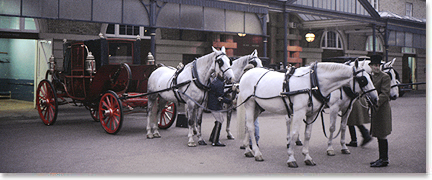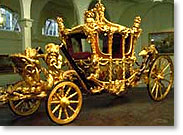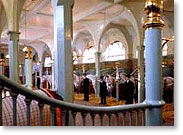Royal Mews - a Brief History

One of the finest working stables in existence, the Royal Mews at Buckingham Palace provides a unique opportunity for visitors to see the work of the Royal Household department that provides road transport for The Queen and members of the Royal Family by both horse-drawn carriage and motor car. The Royal Mews has a permanent display of State vehicles. These include the magnificent Gold State Coach used for Coronations and those carriages used for Royal and State occasions, State Visits, weddings and the State Opening of Parliament. A State motor vehicle is also usually on display.

The Mews first started in its present location in 1760, when George III moved his carriage collection and some of his horses there from a site near Charing Cross.
It was convenient for them to be near to the house which he had just purchased from the Duke of Buckingham - today's Buckingham Palace.
In 1764, George III added the indoor riding school and changed the name of the stables to the Royal Mews Pimlico.
In 1820 George IV succeeded his father as king and set about transforming Buckingham House into a palace worthy of a king and a great nation. He commissioned the famous architect John Nash to remodel the house and rebuild the stables in a grand manner.
Nash built splendid stables around the existing riding school. He designed a Doric arch at the entrance to the central Mews quadrangle. He built the main coachhouses on the east side, and, on the west, he created two sets of State Stables with room for 54 horses as well as forage and harness rooms.
A matching Doric arch and a back or 'upper mews' were added at the north end of the quadrangle. A grand house for the Master of the Horse and his assistant was also created.
The buildings were completed in 1825. Later kings and queens made their own changes to keep this working environment up-to-date.
In 1837, Queen Victoria became the first monarch to use Buckingham Palace as both an official residence and home. This meant greater responsibilities for the Royal Mews. Her husband Prince Albert installed a new forge and added sheds in which a cow was kept.
In 1855 Queen Victoria set up the Buckingham Palace Royal Mews School at her own expense for the children of the servants belonging to the Royal Mews. The school remained for over 20 years. In 1859 new accommodation was built for the 198 members of staff and their families.
Modernisations continue today at the Mews. The most recent is a project to expand the electronic network from Buckingham Palace to the Mews, providing e-mail and Internet access to the staff.
As a working environment, the Royal Mews will develop further in future, ensuring that the important work of this special department can continue.

The Royal Mews is an important working department of the Royal Household. It is at the Royal Mews that the State vehicles are housed and maintained.
These include the magnificent Gold State Coach used for Coronations and those carriages used for Royal and State occasions, State Visits, Weddings and the State Opening of Parliament.
Visitors to the Royal Mews often witness the daily work of the Mews staff. Since 1843 the daily messenger brougham has set out from the Mews to collect and deliver post between Royal households.
Another regular task is that of collecting a newly appointed foreign ambassador from his official residence, conveying him in a carriage to Buckingham Palace for his audience with The Queen, and afterwards returning him to his residence.
On top of this the chores of feeding, exercising, mucking out and training take place throughout the day, making the Mews a unique place to visit.